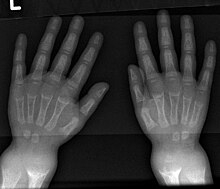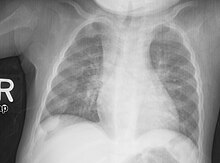Rickets is a softening of bones in immature mammals due to deficiency or impaired metabolism of vitamin D,[1] phosphorus or calcium,[2] potentially leading to fractures and deformity. Rickets is among the most frequent childhood diseases in many developing countries. The predominant cause is a vitamin D deficiency, but lack of adequate calcium in the diet may also lead to rickets (cases of severe diarrhea and vomiting may be the cause of the deficiency). Although it can occur in adults, the majority of cases occur in children suffering from severe malnutrition, usually resulting from famine or starvation during the early stages of childhood.
| Rickets | |
|---|---|
| Specialty | Endocrinology |
Osteomalacia is a similar condition occurring in adults, generally due to a deficiency of vitamin D.[3]
Signs and symptoms of rickets include:
- Bone tenderness [4]
- dental problems[4]
- muscle weakness (rickety myopathy)[5]
- increased tendency for fractures (easily broken bones), especially greenstick fractures
- Skeletal deformity[4]
- Toddlers: Bowed legs (genu varum)[5]
- Older children: Knock-knees (genu valgum) or "windswept knees"
- Cranial, pelvic, and spinal deformities (such as lumbar lordosis)
- Growth disturbance

Wrist X ray showing changes in rickets, mainly cupping is seen here. 
Chest X ray showing changes consistent with rickets, this changed is usually referred to as Rosary beads of rickets - Hypocalcemia (low level of calcium in the blood)
- Tetany (uncontrolled muscle spasms all over the body)
- Craniotabes (soft skull)
- Costochondral swelling (aka "rickety rosary" or "rachitic rosary")
- Harrison's groove[4]
- Double malleoli sign due to metaphyseal hyperplasia
- Widening of wrist[5] raises early suspicion, it is due to metaphyseal cartilage hyperplasia.

Widening of wrist
An X-ray or radiograph of an advanced sufferer from rickets tends to present in a classic way: bow legs (outward curve of long bone of the legs) and a deformed chest. Changes in the skull also occur causing a distinctive "square headed" appearance (Caput Quadratum). These deformities persist into adult life if not treated. Long-term consequences include permanent bends or disfiguration of the long bones, and a curved back.[6]
Types
- Nutritional rickets[7]
- Vitamin D-resistant rickets[7]
- Vitamin D-dependent rickets[7]
- Type I
- Type II
- Congenital rickets
- Newborn rickets
Cause
The primary cause of rickets is a vitamin D deficiency.[8] Vitamin D is required for proper calcium absorption from the gut. Sunlight, especially ultraviolet light, lets human skin cells convert vitamin D from an inactive to active state. In the absence of vitamin D, dietary calcium is not properly absorbed, resulting in hypocalcaemia, leading to skeletal and dental deformities and neuromuscular symptoms, e.g. hyperexcitability. Foods that contain vitamin D include butter, eggs, fish liver oils, margarine, fortified milk and juice, portabella & shiitake mushrooms, and oily fishes such as tuna, herring, and salmon. A rare X-linked dominant form exists called vitamin D-resistant rickets or X-linked hypophosphatemia.
Cases have been reported in Britain in recent years[9] of rickets in children of many social backgrounds caused by insufficient production in the body of vitamin D because the sun's ultraviolet light was not reaching the skin due to use of strong sunblock, too much "covering up" in sunlight, or not getting out into the sun. Other cases have been reported among the children of some ethnic groups in which mothers avoid exposure to the sun for religious or cultural reasons, leading to a maternal shortage of vitamin D;[10][11] and people with darker skins need more sunlight to maintain vitamin D levels. The British Medical Journal reported in 2010 that doctors in Newcastle on Tyne saw 20 cases of rickets per year. Rickets had been a significant malaise in London, especially during the Industrial Revolution. Persistent thick fog and heavy industrial smog permeating the city blocked out significant amounts of sunlight so much so that up to 80 percent of children at one time had varying degrees of rickets in one form or the other.
Diagnosis
Rickets may be diagnosed with the help of:
- Blood tests:[12]
- Serum calcium may show low levels of calcium, serum phosphorus may be low, and serum alkaline phosphatase may be highfrom bones or changes in the shape or structure of the bones.
- Bone biopsy is rarely performed but will confirm rickets.[12]
Treatment and prevention
The treatment and prevention of rickets is known as antirachitic. The most common treatment of rickets is the use of Vitamin D.[13] However, surgery may be required to remove severe bone abnormalities.[7]
Diet and sunlight
Treatment involves increasing dietary intake of calcium, phosphates and vitamin D. Exposure to ultraviolet B light (most easily obtained when the sun is highest in the sky), cod liver oil, halibut-liver oil, and viosterol are all sources of vitamin D.
A sufficient amount of ultraviolet B light in sunlight each day and adequate supplies of calcium and phosphorus in the diet can prevent rickets. Darker-skinned people need to be exposed longer to the ultraviolet rays. The replacement of vitamin D has been proven to correct rickets using these methods of ultraviolet light therapy and medicine.[14]
Recommendations are for 400 international units (IU) of vitamin D a day for infants and children. Children who do not get adequate amounts of vitamin D are at increased risk of rickets. Vitamin D is essential for allowing the body to uptake calcium for use in proper bone calcification and maintenance.
Supplementation
Sufficient vitamin D levels can also be achieved through dietary supplementation and/or exposure to sunlight. Vitamin D3 (cholecalciferol) is the preferred form since it is more readily absorbed than vitamin D2. Most dermatologists recommend vitamin D supplementation as an alternative to unprotected ultraviolet exposure due to the increased risk of skin cancer associated with sun exposure. Endogenous production with full body exposure to sunlight is approximately 250 µg (10,000 IU) per day.[15]
According to the American Academy of Pediatrics (AAP), all infants, including those who are exclusively breast-fed, may need Vitamin D supplementation until they start drinking at least 17 US fluid ounces (500 ml) of vitamin D-fortified milk or formula a day.[16]
Epidemiology
In developed countries, rickets is a rare disease[17] (incidence of less than 1 in 200,000).
Those at higher risk for developing rickets include:
- Breast-fed infants whose mothers are not exposed to sunlight
- Breast-fed infants who are not exposed to sunlight
- Breast-fed babies who are exposed to little sunlight
- Any child whose diet does not contain enough vitamin D or calcium
Mistaken for child abuse
Infants with rickets often suffer bone fractures. This sometimes leads to child abuse allegations. This issue appears to be more common for solely nursing infants of black mothers, in winter in temperate climates, suffering poor nutrition and no vitamin D supplementation.[18] People with darker skin produce less vitamin D than those with lighter skin, for the same amount of sunlight.[19]
History
Greek physician Soranus of Ephesus, one of the chief representatives of the Methodic school of medicine who practiced in Alexandria and subsequently in Rome, reported deformation of the bones in infants as early as the first and second centuries AD. Rickets was not defined as a specific medical condition until 1645, when an English physician Daniel Whistler gave the earliest known description of the disease. In 1650 a treatise on rickets was published by Francis Glisson, a physician at Caius College, Cambridge.[20] The origin of the word rickets is probably from the Old English word wrickken ('to twist'), although because this is conjectured, several major dictionaries simply say "origin unknown". The name rickets is plural in form but usually singular in construction. The Greek word "rachitis" (ῥαχίτης,[21] meaning "in or of the spine") was later adopted as the scientific term for rickets, due chiefly to the words' similarity in sound.
See also
References
- ^ Magnesium and vitamin D's co-factors, by John Jacob Cannell, M.D. citing The Lancet; The Vitamin D Council "Two interesting cases of Mg dependent Vitamin D-resistant rickets appeared in the Lancet in 1974. Two children, one age two and the other age five, presented with classic rickets. 600,000 IU of Vitamin D daily for ten days did not result in any improvement in six weeks—in either x-rays or alkaline phosphatase—and the doctors diagnosed Vitamin D-resistant rickets. Almost by accident, serum Mg levels were then obtained, which were low in both children. After the treatment with Mg, the rickets rapidly resolved."
- ^ TheFreeDictionary > rickets In turn citing:
- The American Heritage Medical Dictionary Copyright 2007 (mentioning vitamin D and phosphates)
- Mosby's Dental Dictionary, 2nd edition. Copyright 2008 (mentioning vitamin D and calcium)
- ^ MedlinePlus Medical Encyclopedia: Osteomalacia
- ^ a b c d Medical News – Symptoms of Rickets
- ^ a b c Mayo Clinic – Signs and Symptoms of Rickets
- ^ Pharmacologyonline. "Rickets and its Management: A Review" (PDF). Retrieved 2 June 2012.
- ^ a b c d Rickets: Not a Disease of the Past
- ^ What causes rickets?on health-cares.net
- ^ Daily Telegraph, page 4, Wednesday 19 January 2011
- ^ Rise in rickets linked to ethnic groups that shun the sun The Independent, published 2011-07-25, accessed 2011-07-251
- ^ Doctors fear rickets resurgence BBC, published 2007-12-28, accessed 2011-07-25
- ^ a b NHS Choice - Rickets Diagnoses
- ^ Meschino Health. "Complete Guide to Vitamin D". Retrieved 2 June 2012.
- ^ Rajakumar, Kumaravel (1). "Vitamin D, Cod-Liver Oil, Sunlight, and Rickets: A Historical Perspective". Pediatrics. 112 (2): e132–e135. doi:10.1542/peds.112.2.e132. PMID 12897318. Retrieved 14 July 2011.
{{cite journal}}: Check date values in:|date=and|year=/|date=mismatch (help); Unknown parameter|month=ignored (help) - ^ Vieth R (1999). "Vitamin D supplementation, 25-hydroxyvitamin D concentrations, and safety". The American Journal of Clinical Nutrition. 69 (5): 842–56. PMID 10232622.
{{cite journal}}: Unknown parameter|month=ignored (help) - ^ Gartner LM, Greer FR (2003). "Prevention of rickets and vitamin D deficiency: new guidelines for vitamin D intake". Pediatrics. 111 (4 Pt 1): 908–10. doi:10.1542/peds.111.4.908. PMID 12671133.
{{cite journal}}: Unknown parameter|month=ignored (help) - ^ National Health Service of England > Rickets Last reviewed: 28 January 2010
- ^ Keller, Kathy A. (22 September 2008). "Rickets vs. abuse: a national and international epidemic" (PDF). Pediatric Radiology. 38 (11): 1210–1216. doi:10.1007/s00247-008-1001-z. PMID 18810424.
{{cite journal}}: Unknown parameter|coauthors=ignored (|author=suggested) (help) - ^ Live Strong. "CDark Skin Color & Vitamin D". Retrieved 2 June 2012.
- ^ Claerr, Jennifer (February 6, 2008). "The History of Rickets, Scurvy and Other Nutritional Deficiencies". An Interesting Treatise on Human Stupidity. Yahoo! Voices.
URL references
{{cite web}}:|archive-url=requires|url=(help); Missing or empty|url=(help) - ^ Greek Word Study Tool


